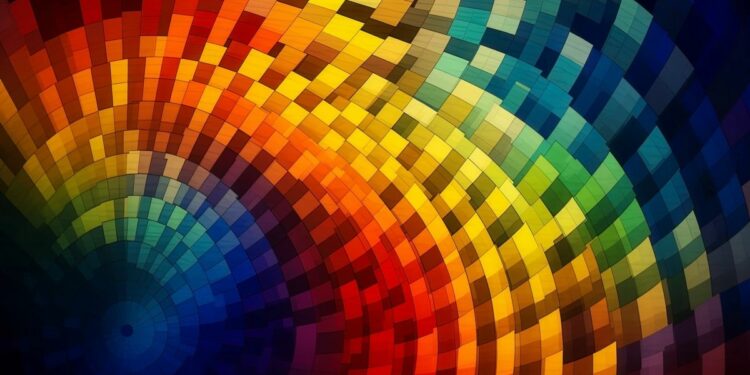In what ways do optical illusions exploit the ambiguity of color perception, and how do they create the perception of nonexistent colors in visual stimuli?
Unveiling the Mystery: The Fascinating Reason Behind Seeing Nonexistent Colors
Have you ever experienced seeing colors that aren’t actually there? Maybe you’ve seen shades of blue or green in places where you know there are only black and white. This intriguing phenomenon is known as seeing nonexistent colors, and it’s a fascinating aspect of human perception that has puzzled scientists and researchers for years.
In this article, we’ll delve into the science behind seeing nonexistent colors, explore some of the potential reasons for this phenomenon, and discuss the impact it has on our understanding of visual perception. So, let’s unravel the mystery and uncover the captivating reasons behind seeing colors that don’t actually exist.
The Science of Color Perception
Color perception is a complex process that involves the eyes, the brain, and the interpretation of light waves. When light hits an object, certain wavelengths are absorbed, and others are reflected. The reflected light enters the eye and is detected by specialized cells called cones, which are located in the retina. These cones are sensitive to different wavelengths of light, allowing us to see a wide range of colors.
The information gathered by the cones is then sent to the brain, where it is processed and interpreted. This process allows us to perceive and distinguish between different colors, contributing to our overall visual experience of the world around us.
However, the perception of color isn’t always straightforward. In some cases, individuals may report seeing colors that aren’t present in the actual stimulus. This can occur in a variety of situations, including afterimages, synesthesia, and optical illusions.
Afterimages and the Opponent-Process Theory
Afterimages are a common example of seeing nonexistent colors. They occur when the eyes are exposed to a particular color for an extended period, causing fatigue in the associated cones. When the stimulus is removed, the fatigued cones produce an afterimage that appears as the complement of the original color.
This phenomenon can be explained by the opponent-process theory of color vision, which suggests that our perception of color is based on contrasting pairs of colors. According to this theory, cells in the visual system respond to red-green and blue-yellow color combinations, creating the perception of color through opposition. When these cells are fatigued, the opposing colors become more apparent, leading to the perception of nonexistent colors in afterimages.
Synesthesia and Cross-Sensory Perception
Another intriguing aspect of color perception is synesthesia, a neurological condition in which stimulation of one sensory pathway leads to automatic, involuntary experiences in a second sensory pathway. For individuals with synesthesia, stimulation of one sense, such as hearing a sound, can lead to the perception of color. This fascinating phenomenon demonstrates the interconnectedness of our sensory experiences and challenges traditional notions of perception.
In the case of synesthesia, individuals may experience seeing colors that aren’t present in the external stimulus, as their perception of color is influenced by auditory, tactile, or other sensory experiences. This unique condition sheds light on the complex and interconnected nature of human perception and the potential for variations in color perception across individuals.
Optical Illusions and Perceptual Ambiguity
optical illusions offer a compelling example of how our visual system can be tricked into perceiving nonexistent colors. Optical illusions exploit the ambiguity and interpretation of visual stimuli, leading to discrepancies between what is actually present and what is perceived by the viewer.
One well-known example of this is the famous “checker shadow illusion,” in which two squares of identical color appear to be different due to the surrounding context. This phenomenon demonstrates how our perception of color can be influenced by factors such as brightness, contrast, and background context, leading to the perception of nonexistent colors in certain visual stimuli.
Practical Tips for Understanding Color Perception
Understanding the science behind color perception and the phenomenon of seeing nonexistent colors can provide valuable insights into how we experience the world around us. Whether you’re an artist, designer, or simply someone with a curious mind, here are some practical tips for understanding color perception:
Experiment with afterimages: Try creating afterimages by staring at a colorful image or object for an extended period, then shifting your gaze to a neutral background. Pay attention to the colors that appear in the afterimage and consider how they relate to the original stimulus.
Explore synesthesia: Learn more about synesthesia and the ways in which sensory experiences can influence color perception. Consider how the interconnected nature of sensory pathways can influence the perception of color in unique and unconventional ways.
Study optical illusions: Explore different types of optical illusions and consider the ways in which they exploit the ambiguity of color perception. Reflect on how factors such as contrast, context, and visual processing can influence our perception of color in these illusions.
Case Studies: Real-Life Examples of Nonexistent Color Perception
To further illustrate the phenomenon of seeing nonexistent colors, let’s explore some real-life case studies of individuals who have experienced unique and intriguing instances of color perception:
Case Study 1: Artist’s Afterimage Inspiration
A well-known artist reported experiencing vivid afterimages that inspired her artwork. After staring at bright, colorful landscapes for extended periods, she would see vibrant, swirling patterns of color when she closed her eyes. These afterimages served as the inspiration for her abstract paintings, highlighting the creative potential of seeing nonexistent colors.
Case Study 2: Synesthetic Sensations in Music
A musician with synesthesia described experiencing colors in response to different musical notes and melodies. For her, certain musical compositions elicited specific colors and patterns in her mind’s eye, creating a unique cross-sensory experience that influenced her creative process. This case study demonstrates the interconnected nature of sensory experiences and the potential for synesthetic sensations to influence color perception.
First-Hand Experience: Exploring Nonexistent Colors
To gain a firsthand understanding of nonexistent colors, consider conducting simple experiments and observations to explore this phenomenon for yourself. Here are a few activities you can try to engage with the concept of seeing nonexistent colors:
Activity 1: Inducing Afterimages
Find a colorful image or object and focus on it for approximately 30 seconds. Then, quickly shift your gaze to a blank, neutral surface, such as a white wall or a piece of paper. Pay attention to the colors that appear in the afterimage and note any unexpected or nonexistent colors that manifest.
Activity 2: Synesthetic Reflection
Listen to a variety of musical compositions and pay attention to the sensations and imagery that arise in response to the music. Consider how different sounds and melodies may evoke specific colors or visual patterns in your mind, reflecting on the potential for cross-sensory experiences to influence your perception of color.
By engaging with these activities and exploring the fascinating world of color perception, you can gain a deeper appreciation for the complexity and diversity of human visual experiences.
the phenomenon of seeing nonexistent colors offers a captivating glimpse into the intricate workings of human perception. From afterimages and synesthesia to optical illusions and real-life case studies, the ways in which we perceive color are influenced by a variety of factors, leading to the perception of colors that aren’t actually present in the external stimulus.
By embracing the complexity and variability of color perception, we can gain a greater understanding of the intricacies of human vision and the potential for unique and unconventional experiences of color. So, the next time you find yourself experiencing a color that doesn’t seem to belong, take a moment to appreciate the wonder and mystery of seeing nonexistent colors.
Have You Ever Experienced Seeing Colors That Don’t Actually Exist?
Chances are, you’ve had an experience with an optical illusion that made you see colors that weren’t really there. The famous photo of ”the dress” is a prime example. Some people saw it as white and gold, while others saw it as blue and black. This begs the question: how can colors appear different from what they actually are?
In some cases, the answer lies in the lighting, while in others, it depends on our memories or what our photoreceptors are doing, Live Science explains.
Dressing Controversy
In 2015, a photo of a dress sparked a heated debate with the simple question of what color it was. Bevil Conway, a neuroscientist and visual scientist at the National Institutes of Health, led a team in analyzing the dilemma. They found that people’s expectations of the lighting of the dress influenced what colors they believed it to be. Those who assumed the dress was shot under warm or incandescent light saw it as blue and black, while those who assumed cool or daylight lighting saw white and gold.
This finding showed that people’s expectations of the object’s surroundings influenced their color perception, challenging the notion that colors are always perceived the same way.
Memory’s Influence on Color
Memory can also play a significant role in the way we perceive colors. A 2024 study showed that despite different lighting conditions, people had no trouble identifying the original colors of objects. This phenomenon, known as color constancy, suggests that when we view familiar objects, our brains assign them their expected hue or enhance their color.
Additionally, when objects are unfamiliar, our brain can assign colors based on what we expect the object to look like.
Context and Positioning
An object’s positioning or context can also affect our perception of color. For instance, a red object appears “redder” on a green background than on a white background, demonstrating that surrounding colors can change how we perceive certain hues.
Tired Photoreceptors
Occasionally, our cones, or color photoreceptor cells in the retina, can trick the brain into “seeing” something that’s not there. This is evident in the afterimage phenomenon, where staring at an image for a prolonged time can cause a vivid image to appear afterward.
It’s important to note that our cone cells can get tired, creating illusions of complementary and positive afterimages. However, there is still much to learn about how our brains perceive color, especially in terms of where in the brain this processing occurs.
understanding color perception requires an interdisciplinary approach that incorporates art, philosophy, and science. This dialogue is essential for shedding light on the complexities of color perception beyond just the visual aspects.






